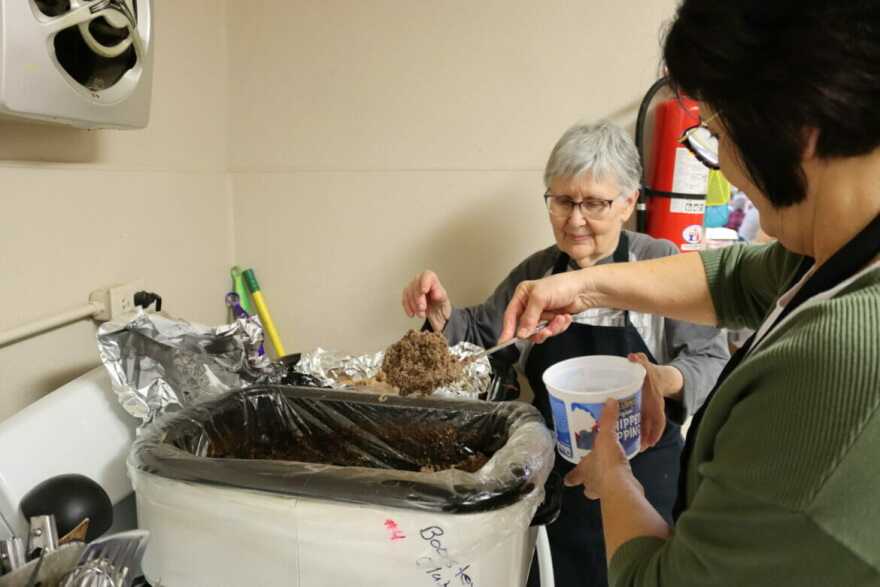CUBA, Kansas — Snow blew into town sideways last Thursday, delivering a spring break blizzard.
Inside the basement of Community Hall, warm cheerful faces gathered. Polka music and chatter filled the long rectangular room, and the aroma of pork and kraut wafted from serving dishes.
It was “Czech Day” and the start of Cuba’s 46th Rock-A-Thon event, an annual (excluding COVID years) fundraiser for the small farming community with Czech roots.
What started as a friendly competition with a neighboring town to see who could keep a rocking chair oscillating the longest, has turned into an annual tradition of food and merriment.
“It sounds kind of hokey, but after 46 years, we consider it a major event,” said Tom Lesovsky, a member of Cuba Booster Club.
The Rock-A-Thon has become an unlikely catalyst for bringing folks to town. High school reunions are planned around the event. Friends reconnect after moving away. And families plan to visit over spring break.
Through the Years
One day, shortly after moving to Cuba with her husband in the mid-1970s, Connie Shulda loaded up her laundry and headed to the town laundromat.

When she stepped inside, she met a crowd of people, a band playing polka music in the corner, rows of crockpots and baking dishes on top of the washing machines and a couple of folks in rocking chairs.
“I didn’t get any laundry done,” Shulda laughed about her introduction to the Rock-A-Thon.
For the first couple of years, the Rock-A-Thon was held in the laundromat. Rockers were sponsored to raise money, and everyone shared food and beer potluck style for a full week.
Funds raised from the Rock-A-Thon were used to upgrade the basement of Community Hall from dirt floors to one of the best gathering places in Republic County, and home to the Rock-A-Thon.
Sharon Larsen sang along to one of the polka songs performed by Joe Dolezal during Czech Day on Thursday.
Cuba was settled in the 1870s by primarily Czech and Austrian immigrants. Today, most folks are fourth- or fifth-generation Czech, but Larsen said growing up in a town rich with Czech heritage, polka was just the type of music she and her friends always heard.
“And that’s what we’d dance to with our boyfriends,” Larsen said and smiled at her husband sitting next to her.
The two have been together for more than 60 years and started dating when she was 14 and he was 15.
Many of the folks who sat and enjoyed polka music for hours had similar stories. Many spoke with pride of successful marriages with high school sweethearts and generations of living and farming on the same land.
Judy and Vincent Pachta grew up going to dances upstairs in Community Hall (which still sports an antique, glittering disco ball) and celebrated their 50th wedding anniversary in the building’s basement.
“It’s the nicest building in the county,” Judy Pachta said.

The Rock-A-Thon continued annually starting in 1976, becoming a little more organized each year by the Cuba Booster Club. Rock-A-Thons grew to include guest speakers, activities and an auction.
Through it all, the rocking competition that initially inspired the event continued. Adults would often chaperone teenagers who took the overnight rocking shifts.
Lesovsky said each year the event raises between $20,000 and $25,000. The club pours that money right back into the community, renovating its public spaces like Community Hall and helping with things the city can’t afford.
This year, Lesovsky said the Rock-A-Thon raised more than $16,000 from the auction. After expenses, he estimated another $8,000 was raised from food sales and donations.
“We are super pleased with that,” he said.
In addition to its normal projects and upkeep, Lesovsky said the booster club hopes to use the funds to repair some of roads in town and to clean up abandoned properties.
No one rocked in 2020 or 2021 due to the COVID-19 pandemic. Last year, the Cuba Booster Club resurrected the event but decided to scale it back from a week-long jubilee to a three-day shebang.
“It takes just about everybody in town to make it work,” Lesovsky said.
The three-day version was more manageable for the small town of 140 people, so they kept the shortened format this year as well.
With the success of the auction, rocker sponsorships have become a thing of the past.
Now, attendees sign up to rock for an hour or two to keep the chairs going throughout the event, and the rockers are there for the tradition more than anything else.

This year the event included visits from a former Kansas State University football player and the KC Wolf mascot, cookie decorating, a baking competition, roller skating, BINGO, dueling pianos and lots of homecooked food.
Rock Together Now
“You wanna rock young lady?” an older gentleman asked as he gave up his rocker to a child.
One of Jane Baxa’s grandchildren climbed into the plush glider next to her grandmother, who held another of her grandchildren on her lap and rocked. Baxa beamed in the rocker — happy to have her family at home in Cuba with her.
Baxa, who grew up in Cuba and still lives there, said her family doesn’t make it to the Rock-A-Thon every year, but when they do, “they just love it.”
The event holds a similar power for a lot of folks.
A group of ladies clustered together, bought a box of homemade kolaches and examined the framed photos of Cuba’s graduating classes on the walls. They were sisters and cousins who relished a joyful reason to visit home at a time when one said it seems like they only gather at funerals.
The Cuba High School graduating classes of 1974 and 1975 plan their reunions to coincide with the event, and folks who have moved away enjoy coming back to see familiar faces.

“That’s been kind of the best part of it,” Cecilia Harris said. “You have Facebook … but it’s kind of nice to come together and see people face to face.”
The friends who grew up within a mile of one another get to socialize and have the familiar taste of their Czech heritage.
“We really appreciate the local people and all the work they do to give us a place to come together,” Nita Newby said.
A big draw for many people is the heaping plates of homecooked food. The Rock-A-Thon serves breakfast, dinner and supper on all three days of the event. Fried chicken, chicken fried steak, pastries, and most popular, the Czech dinner.
The Czech dinner included roast pork, jaternice (pronounced “ya-ter-neat-sa,” a Czech-style sausage) sauerkraut, dumplings, green beans and a generous ladling of gravy over top.
In one word: satiating.
None of it could happen without the hardworking ladies who volunteer in the kitchen.
Close to 200 people either dine in or take a meal to go at each dinner.
That’s a heck of a lot of hand-prepared food, but the ladies said it’s much easier than when the Rock-A-Thon stretched a full week. Still, planning and prepping Rock-A-Thon food takes several months.

“We ask very few (people) they just come in and volunteer,” Marilyn Junek, one of the kitchen organizers said.
That’s pretty much the theme for the Rock-A-Thon. Folks see that something needs doing, and they just do it.
After lunch, Randy Kauer washed dishes. He was one of several folks who stepped in to help.
“The women cook the food, and the men are supposed to do the dishes,” Kauer said about the way it’s always been.
Of course, anyone is welcome to help with the dishes. Jennifer Joy found her way into the kitchen after dinner to dry dishes as Kauer handed them to her. She lives in Wichita now but grew up in Cuba and was excited to come back for the Rock-A-Thon this year.
“It’s pretty cool,” Joy said. “You see a lot of the same faces that you see year after year.”
As soon as the kitchen is cleaned up, the volunteer chefs get right back to work preparing the next meal.
“Oh, we’ll find time to get a break,” Naomi Adams, one of the ladies of the kitchen said, then laughed, “And maybe get a beer.”
Somewhere between lunch and dinner, they found time to sit around two large tables, with family members and anyone else who walked in to help peel and cube potatoes in preparation for dinner the next day.
Like so much of rural America, Cuba faces a declining population. Its high school closed in 2007 and the many small family farms that used to steward its surrounding land have been replaced by just a few big ones.
Yet, folks in town aren’t discouraged. They see a community that supports one another, something that’s especially evident during the Rock-A-Thon.
Maybe it’s because they’ve stuck around long enough to see community and Rock-A-Thon leadership passed down through several generations, but no one seems worried about the future.
“You just have to involve them and hopefully when we get too old, they’ll pick it up,” Lesovsky said. “That’s kind of what we did, we just had to watch and learn.”

He spoke with admiration at the Cuba Booster Club’s new president, Trent Skucius, as he took on his first Rock-A-Thon as president.
“It’s a great place to live,” said Skucius, who has lived in Cuba for 45 years. “Especially how the community comes together and does this.”
As he spoke, booster club members, friends and families unloaded racks of folding chairs in preparation for the guest speakers later that night. Folks didn’t sign up to volunteer or get asked to help with specific tasks. They just saw work that needed to be done, so they got up to help.
“You don’t see people doing that like what they do here,” Skucius said referencing the folks working around him. “When someone starts doing something, we just start helping out.”
For 40 years, National Geographic photographer Jim Richardson chose to photograph the people of Cuba and document their resiliency and community strength.
Decades, a pandemic and a nearly 50% decline in population later, the same is true.
This story was originally published on Flatland, a fellow member of the KC Media Collective.
Copyright 2023 KCUR 89.3. To see more, visit KCUR 89.3. 9(MDA4OTAxNzAzMDEzMjc0MTc2MzA5ZDZlMw004))







